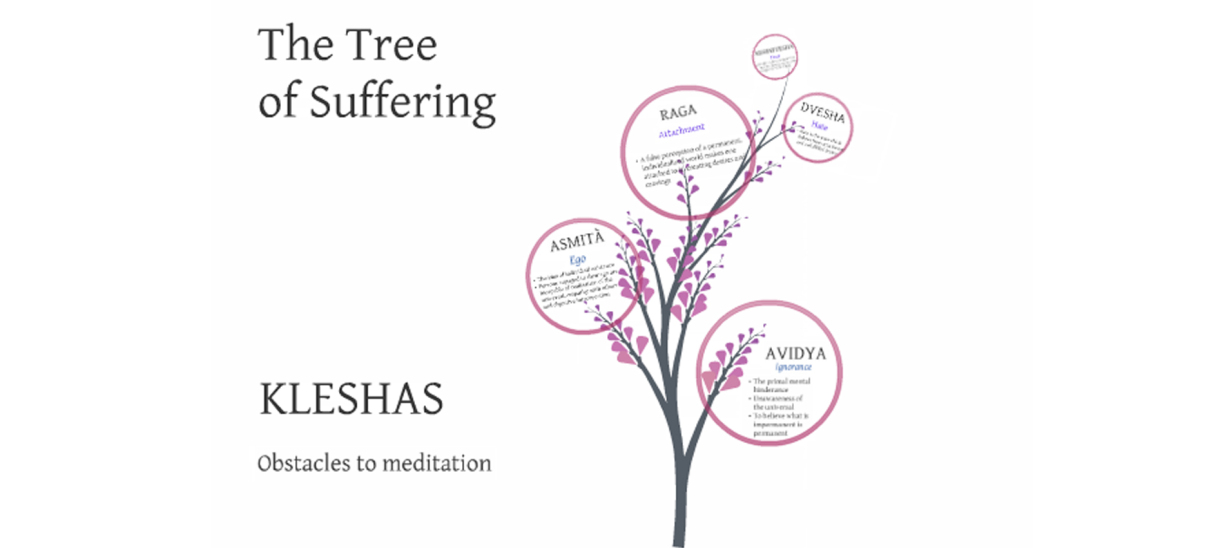Klesha meaning: exploring the five hindrances in Yoga philosophy

The 5 Kleshas are the main causes of suffering in our lives
Klesha meaning, definition or kleśa (क्लेश) is a Sanskrit term that translates as obstacle, affliction, poison, pain, and distress. Klesha is the closest way of writing this word as its pronunciation, but sometimes it’s transliterated from Sanskrit as kleśāḥ.
Kleshas are internal obstacles that arise in our minds and cause us suffering. They can create powerful disturbances in our inner world and act like poison in our lives. We can also view the 5 kleshas as mental afflictions or afflictive emotions.
There are slightly different definitions and ways of understanding kleshas depending on the spiritual tradition. Kleshas are mentioned in the Yoga Sutras (written and compiled by the sage Patanjali) and the different Buddhist traditions.
The number of main kleshas that affect us varies depending on the tradition that you are a student of. But the concepts are similar because they are all seen as hurdles that we find and have to overcome on our spiritual path.
So, how do we understand kleshas according to these traditions?
The Yoga Sutras describe five kleshas that cause us suffering.
These obstacles on the spiritual path are the root cause of all our pain and suffering in this human experience. We lose our insight when we live our lives based on kleshas.
They cause tendencies for actions with undesirable consequences (in this context, “consequences” in the Sutras is translated as “karma”).
The suffering that the Sutras describe is caused by changes from the outside world, disturbing our inner world. It is also caused by samskaras (desires), vritti (misconceptions), impressions, and conflict.
Once we know that our suffering is caused by change, we can maintain a healthy awareness that any life changes may cause us pain if we are not aware.
Also Read>>> Patanjali’s Yoga Sutras
When we are aware, we realize that change is a part of life and fighting it is where suffering arises.
Being overly attached to old things (even if they have caused us happiness) will invite pain to arise when they can no longer give us the same kind of joy.
Hence, being aware of the kleshas before they cause a negative sense of suffering is important for our spiritual growth.
The sutras mention that the 5 kleshas must be let go or cut off as soon as they begin to grow or arise.
These five obstacles make our lives more difficult than they need to be! Preventing the kleshas from growing deep roots within ourselves will help deepen our practice and achieve liberation and be in touch with our true self once more.
The 5 kleshas in the Yoga Sutras are:
Avidya – Ignorance
Avidya is ignorance, but it can also be translated as “lack of insight.” It’s the source of most kleshas, which is why it’s one of the most important kleshas that we need to face.
It’s when, for example, we view anything temporary as something eternal. We think our negative emotions will last forever – but in truth, they will not.
In other words, we don’t see its true nature. We aren’t able to see the temporary nature of negative emotions, and we cannot see the true nature of ourselves.
Also Read>>> Online Streaming Yoga Classes
This can cause tension when things don’t happen the way we expect them to because we ignorantly see something for what it’s not.
When we are ignorant of our true nature, it causes pain, and if we are not careful, it causes suffering. Remembering our nature – that part of us that is always loving, peaceful, and unchanging – helps to navigate avidya.
Asmita – Egoism
Asmita is when we believe that there is a self that’s separate from everything around us. It puts the ego on a pedestal and values earthly, material possessions more than anything else.
All that matters is how “I” perceive something or how it affects “me.” Suffering comes since the ego always needs external approval, but that approval isn’t always there.
We may take things too personally, and pain arises from not having our expectations met.
This over-identification with the ego makes us forget our true nature as beings made up of the same things as everything else in the universe. We forget about others around us.
We forget that we are eternal and far larger in our connection to the divine than our physical bodies.
Raga – Attachments
Raga is the attachment to our desires. It’s when we assume that our happiness all depends on external factors.
We’re worried that our external sources of happiness will disappear or be taken away, so we cling to them and become attached. Strong attachments create insecurity, anxiety, and fear.
This implies that everything that we could ever need for true happiness lies in our inner world.
Desires will arise since they are a part of living a human experience, but what we choose to do with them affects how they take root within us.
If we are too attached to fulfilling our desires because they make us happy, we will experience pain when they don’t.
We already have the tools to create true happiness within us.
Remembering this will help us from depending too heavily on external, material things for our happiness.
Dvesha – Aversions
Dvesha is avoiding things that cause us unhappiness. It’s based on the presumption that external things are the ones causing afflictive emotions, pain, and suffering. We’ll do anything to avoid them.
Anything that threatens the ego, we avoid them.
When strong desires control us, we develop strong aversions when those desires aren’t filled.
They’re two sides of the same coin – they rely on each other. When, in reality, it’s all happening on the inside!
If we walk through life while being mindful of our emotions, we won’t shut down in the face of things that have made us unhappy in the past.
Aversion causes our suffering as it also brings fear and anxiety.
Especially if we actually need to do the things that caused us unhappiness in the past (like making a doctor’s appointment, for example).
It’s a part of life. We can’t avoid everything that doesn’t cause us happiness.
Abhinivesha – Fear/Anxiety
Abhinivesha is the fear or anxiety that we will lose our attachment to life. Deep down, we know that the only thing constant in life is change, yet it’s one of the most common fears, especially the fear of death.
We fear death because we’re afraid that we’ll lose all the material things we have in the world. The fear arises because we are facing something that we can’t control.
It can also be understood as a fear of change.
Since change is letting go of anything that we were attached to and make room for things to come.
When we are carried away with our attachments and aversions, fearing change will follow. The fear of change causes suffering when it consumes us, and we forget to appreciate every day as a gift.
Living in fear isn’t truly living. Instead of being consumed by fear, we should live life just as it is! This one of the ultimate attachments that we have, but we can still learn to let go of it.
Buddhist teachings describe the 5 kleshas as the source of all individual and worldly problems.
Buddhist teachings in Sanskrit call our mental afflictions kleshas. They are also called kilesas in Pali, the language of the Theravada Buddhist scriptures.
Kilesa comes from the Pali word “kilissati,” which means troubles, soils, or stains. Kleshas or kilesas temporarily taint the true nature of the mind, and they show up in how we talk, how we think, and what we do with our bodies.
They set off an impulsive reaction if we are not careful to catch it.
In a Buddhist understanding, Kleshas can have a strong hold on us because we are not aware of their fragile nature – they don’t have much power if we don’t give them power.
We often reinforce them with our thoughts. Kleshas can also be understood as emotions, in a way, although that’s not how they’re usually defined. When they gain power, however, emotions can destructively wreak havoc.
In the teachings of the Buddha, there are three main mental afflictions. They cause all other types of kleshas and create suffering within ourselves and cause suffering within the world.
These kleshas are known as the Three Poisons in the Mahayana tradition and the Three Unwholesome Roots in the Theravada tradition.
The things we say, think, and do can be affected by the poisons or unwholesome roots. They can create destructive karma and cause suffering in return.
In the Mahayana tradition, which mainly uses the Sanskrit language, the Three Poisons are:
- Moha (or avidya) – ignorance
- Raga – attachment, greed
- Dvesha – aggression, anger
Similarly, in the Theravada tradition, which mainly uses the Pali language, the Three Unwholesome Roots are:
- Moha – delusion
- Lobha – greed
- Dosa – aggression
They are usually depicted as three different animals in artistic portrayals of the Wheel of Life.
The pig represents ignorance or delusion, the rooster represents attachment, and the snake represents aggression.
They aren’t something inherent in us – we pick them up along the way. Another way to put it is that we make mistakes throughout our lives in the form of kleshas, and they can stick with us if we don’t work to let them go. Sometimes they root themselves very deeply within us, but they are not part of who we truly are.

So, how do we make sure the 5 kleshas don’t consume us?
These obstacles or obscurations make life difficult, but that doesn’t mean that there is no way around them.
We are, after all, wholly complete beings that already have everything we need within us. It’s just a matter of tapping into our true nature and liberating it from the heavy burdens that kleshas and all earthly obstacles place on us when we encounter them.
Here is our task – Eliminate our ignorance on how we live our lives! Cease to live on auto-pilot. It’s easier said than done, but it is possible.
How do we go about doing this, though? How do we gain awareness of the kleshas and let go of our ignorance of them?
What kind of practices and forms of guidance can we welcome into our lives to make peace with the kleshas?
The Yoga Sutras provide us with a reminder that we can prevent our future suffering.
A reminder that we ultimately have the strength to prevent causing ourselves pain and suffering. When we can prevent causing ourselves pain, we can remember our true nature.
The sutras encourage us to keep our goal in mind and to keep going, continuing our practice – especially on days when it’s hard.
To combat daily distractions and challenges, we need to develop a daily ritual that brings us back to our awareness.
This can be any form of practice that increases our understanding of our bodies and everything entering and leaving it. Through physical yoga, meditation, and breathing practices, we can always return to ourselves.
It will continually bring you back to your true nature by facing kleshas with yoga training online.
This routine combination will also help guide us back to our insight. As insight and wisdom dispel ignorance, our practice helps us slowly dismantle the first klesha (avidya) that is often the root cause of all the other kleshas.
Importantly, when we eliminate the first klesha (which is avidya or ignorance), we can dissolve the rest of our afflictions.
When we understand our true nature – the never-ending state of love and peacefulness – we know deep down that we actually have nothing to fear at all.
There is no room within eternal love and peacefulness for egoism, aversion, and attachment.
With this patience, diligence, and rigor, keeping the goal in line with our practice, the kleshas will stop having such a strong hold on us in our spiritual path.
When we regain our insight, we can liberate our true selves. We can also do that by honoring and being in harmony with ourselves.
Buddhist teachings remind us to rid ourselves of the poisons as best as we can.
We can do this with the antidotes to the three poisons or unwholesome roots. Ignorance is dispelled by wisdom, hate or aggression is dispelled by loving-kindness, and greed is dispelled by generosity.
It is not just enough to follow good teachings and virtues, but also to be mindful and let go of the negative ones. These things must both be done at the same time.
Questions may arise, such as how to remove the 5 kleshas entirely? The reality is, there may be no real way to “remove” the 5 kleshas as we will continue to encounter them in our human lives.
It’s more important to think about how we respond to them. Someone who is in a very advanced place in their spiritual path may still encounter them. The difference is how one greets them, lets them go, and focuses on virtuous conduct instead.
In meditation or daily life (and these two things are also the same thing), Buddhist practice teaches us to be mindful and attentive when the kleshas arise.
It is best not to dwell on them as that gives the kleshas power to cause us suffering. Nurturing positive attitudes and virtues instead of focusing on the kleshas will make sure that their strength is lessened.
The Buddhist teachings of mindfulness and attentiveness can help to alleviate suffering. Through the presence of wisdom regarding our emotions, the path to liberating ourselves from our afflictions becomes easier.
It helps to be diligent in our practice and remember that the kleshas are not part of who we are – they don’t hold much substance if we don’t give them any substance to work with.
Through meditation, we’re able to cultivate our awareness better and alleviate the kleshas.
Through insight, we see the true nature of ourselves, the mind, and the kleshas. The disturbances will no longer be able to distract us.
There are also rituals that Buddhist traditions conduct to help cleanse the kleshas. In Japanese Buddhism, for example, the temple bell is rung 108 times to rid practitioners of the 108 afflictions, or bonno.
The bell is usually rung 107 times on the night of New Year’s Eve, with the 108th ring after midnight.
This is traditionally done on New Year’s which is called shogatsu (正月) or oshogatsu (お正月).
The ringing of the temple bells is called Joya no Kane (除夜の鐘), and they are rung leading up to midnight to welcome the new year. With this practice, the bell ringing is believed to help everyone enter the new year with purified hearts.
In short, the 5 kleshas are a source of our suffering, but they can also be a source of our growth.
When we have the mindset of taking every difficult obstacle as a lesson for us to remain mindful and kind to ourselves, any klesha we encounter can be a source of spiritual growth.
We have the power to alleviate our suffering when we persist in our practice and know that the 5 kleshas are not part of our shortcomings but a part of life that we can learn from.
When we remain on the spiritual path to liberating our true selves, we are also slowly contributing to liberating the world of its suffering.
Our spiritual growth affects how we can positively respond to others’ sufferings, how we contribute to our lives and theirs, and how we help the causes we care about.
We must choose wisdom, loving-kindness, and generosity as essential things in our lives. How much we hold our awareness and persisting in our practice to bring us closer to our true nature will positively affect us and everyone around us.
We are on the right track as long as we remember how much agency we have over the kleshas we encounter!



